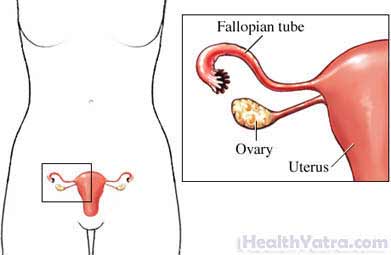Definition
Infertility is not being able to conceive after a year of trying. This means having regular, unprotected sex. About one-third of cases are caused by male factors. An equal number are caused by female factors. In the remaining cases, the cause is unknown or is due to problems with both partners.
Causes
Successful conception involves many steps:
- An egg is released from the woman’s ovaries (ovulation).
- The egg travels to the fallopian tubes. Here the man’s sperm can fertilize it.
- If the egg is fertilized (conception), it moves down the fallopian tubes to the uterus.
- It implants itself into the wall of the uterus. It then begins its 40 weeks of fetal growth.
Most cases of infertility are due to problems with ovulation or problems with fallopian tubes.

Problems with Ovulation
If the egg is not released from the follicle in the ovary, you will not be able to conceive. Up to 40% of cases are due to this. Some factors that can cause problems are:
- Hormonal disorders
- Polycystic ovarian syndrome
- Ovulation disorder
- Ovarian cysts
Problems with Fallopian Tubes
If the fallopian tubes are damaged or blocked, it is difficult for the egg to be fertilized or to travel to the uterus. Problems can be caused by:
- Pelvic inflammatory disease
- Endometriosis
- Previous surgeries which have changed pelvic structures or caused scar tissue in the pelvis
- Ectopic pregnancies
- Birth defects
Risk Factors
These factors increase your chance of developing infertility:
- Age: older than 35 years old
- Very high or very low levels of body fat (resulting in lack of ovulation), obesity
- Excessive exercise (causing to severe a loss of body fat)
- Chronic diseases, such as:
- Diabetes
- Lupus
- Arthritis
- Hypertension
- Asthma
- Smoking
- Caffeine consumption
- Alcohol intake
- Occupational exposure to:
- High temperatures
- Toxic substances
- Chemicals
- Pesticides
- Radiation
- Constant stress
- History of:
- Pelvic inflammatory disease
- Endometriosis
- Polycystic ovaries
- Ectopic pregnancy
- Kidney failure
- Cirrhosis
- Pituitary tumors
- Anorexia nervosa
- Autoimmune hypothyroidism
- Uterine fibroids
- Pelvic surgery (including uterine surgery)
- Ulcerative colitis
- Crohn disease
- Epilepsy
- Cushing’s disease
- Sickle cell anemia
- HIV infection
- Kidney disease
- Appendicitis with complications (ruptured appendix)
- Medications, including
- Acetaminophen
- Ibuprofen
- Pain medications
- Antibiotics
- Antidepressants
Symptoms
After one year of trying to conceive, you and your partner should seek help.
Diagnosis
During the first visit, you will both be evaluated. The doctor will ask about symptoms and medical history. Your doctor will look for physical problems that might cause infertility.
The following tests may be done to see if you are ovulating:
- Basal body temperature—rises at ovulation and remains elevated during the second half of your cycle and throughout pregnancy; you take your temperature every day and record it on a chart
- Blood test—to measure hormone levels
- Endometrial biopsy—to see if ovulation is causing changes in the lining of the uterus
The following may be done to check if your uterus and fallopian tubes are normal:
- Hysterosalpingography (HSG)—an x-ray of the uterus and fallopian tubes
- Transvaginal ultrasound—a device inserted into the vagina to take a “picture” of the pelvic organs
- Hysteroscopy—a thin device inserted through the cervix to look inside the uterus
- Laparoscopy—a small device with a camera is inserted into incisions in the abdomen, allowing the doctor to examine the fallopian tubes, ovaries, and uterus
Treatment
Treatment depends on what is causing the condition. Treatments can be costly and lengthy. They often are not covered by insurance.
Lifestyle Changes
Your doctor may suggest that you first try:
- Changing the timing of sexual activity (to match your pattern of ovulation)
- Maintaining a healthy weight
- Avoiding tobacco and alcohol use
- Avoiding excessive exercise
- Decreasing stress and getting help for depression
Medication
If you do not ovulate, you may be given medications that cause ovulation. The likelihood of multiple births is increased with these medications.
Surgery
If the fallopian tubes are blocked, you may need surgery to open them. Surgery is also used to repair problems with organs or to remove:
- Ovarian cysts
- Fibroids
- Scar tissue
Assisted Reproductive Technologies (ART)
ART involves using human sperm and eggs or embryos in a lab to help with conception. The eggs and sperm can be from you and your partner or donated. ART methods include:
- Artificial insemination—semen is collected and processed in a lab. It is then inserted directly into the woman’s cervix or uterus.
- In vitrofertilization (IVF)—several mature eggs are removed from the woman’s body and mixed with sperm in a lab. The egg and sperm mixture or a 2-3 day old embryo is then placed in the uterus.
- Gamete or zygote intrafallopian transfer (GIFT or ZIFT)—an egg is removed from the woman’s body and mixed with sperm in a lab. The egg and sperm mixture or a 2-3 day old embryo is then placed in the fallopian tube.
- Blastocyst intrafallopian transfer—an egg is removed from the woman’s body, injected with sperm, and allowed to develop. It is later implanted into the uterus.
- Intracytoplasmic sperm injection—a single sperm is injected into the egg. The resulting embryo can be implanted into the uterus or frozen for later use.
Prevention
Not all causes of infertility can be prevented. The following steps may help:
- Stop smoking.
- Limit or avoid caffeine and alcohol.
- Maintain a healthy body weight.
- Protect yourself from sexually transmitted diseases (STDs) by using condoms. Minimize the number of sexual partners you have.
- Try stress management techniques.
